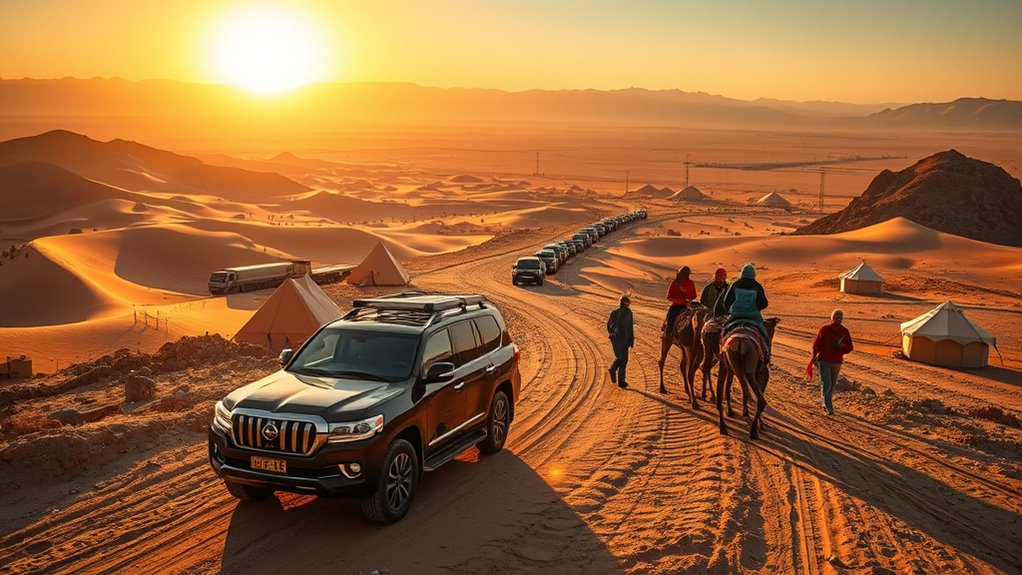Beginning an adventure across the modern Silk Road lets you explore ancient trade routes, vibrant cultures, and stunning landscapes from China to Central Asia and beyond. You’ll visit historic cities, marvel at architectural wonders, and experience local traditions and cuisines. Trek through rugged mountain passes, bustling markets, and desert oases that still serve as gateways to diverse cultural exchanges. Keep exploring, and you’ll uncover the rich history and vibrant present of this legendary route.
Key Takeaways
- Explore historic trade cities like Samarkand and Xi’an, showcasing ancient architecture and vibrant markets along the modern Silk Road.
- Traverse mountain passes and desert oases, experiencing breathtaking scenery and cultural hubs that connect diverse civilizations.
- Engage in outdoor activities such as trekking, mountain biking, and horseback riding through varied terrains from lush valleys to desert dunes.
- Discover local goods, traditional crafts, and regional cuisines that reflect centuries of cultural exchange and heritage.
- Plan your journey with practical tips on visas, packing, and local customs to enhance exploration and cultural immersion.
Tracing the Historical Roots of the Silk Road
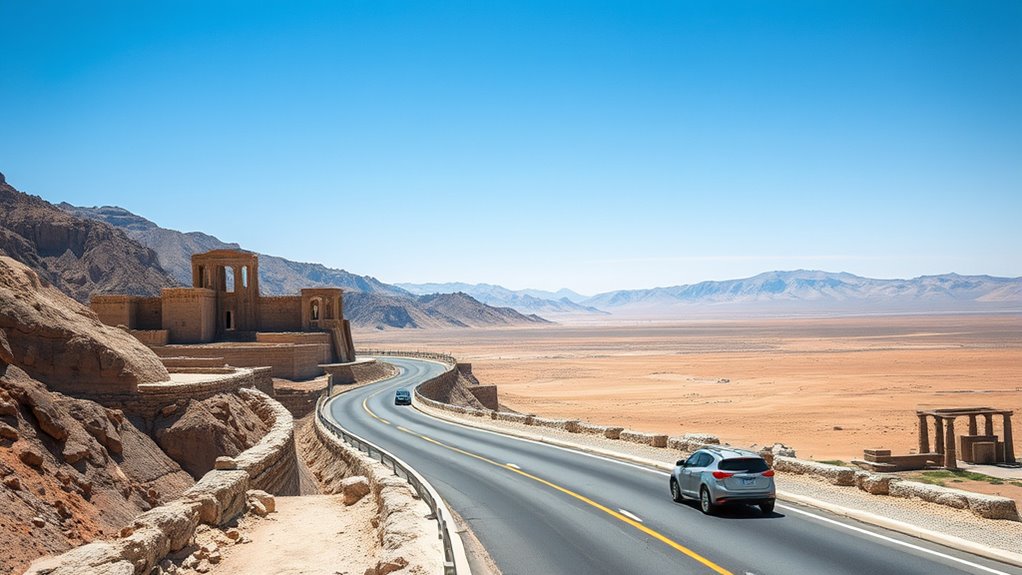
The Silk Road’s origins trace back over two thousand years, serving as a pivotal network that connected China to the Mediterranean. You’d find traders and travelers crossing vast deserts, mountains, and plains, exchanging goods, ideas, and cultures along the way. This route wasn’t just about silk; it carried spices, precious stones, and even religions like Buddhism and Christianity. Its development reflected the growing demand for luxury items and the desire for cultural exchange. Over centuries, the Silk Road evolved, influenced by political changes and technological advances. It played an essential role in shaping civilizations, fostering economic growth, and spreading innovations. Understanding its roots helps you appreciate the deep history behind today’s efforts to revive and modernize this legendary trade network. Additionally, the route facilitated the transfer of technologies, which significantly impacted the development of civilizations along its path. The exchanges along the Silk Road also included the spread of artistic styles, enriching the cultural tapestries of the connected regions. Furthermore, advances in transportation technology helped to expand and sustain these crucial trade routes over time. The integration of new materials and design techniques from different cultures also contributed to innovations in craftsmanship and art.
Key Destinations Along the Modern Silk Road
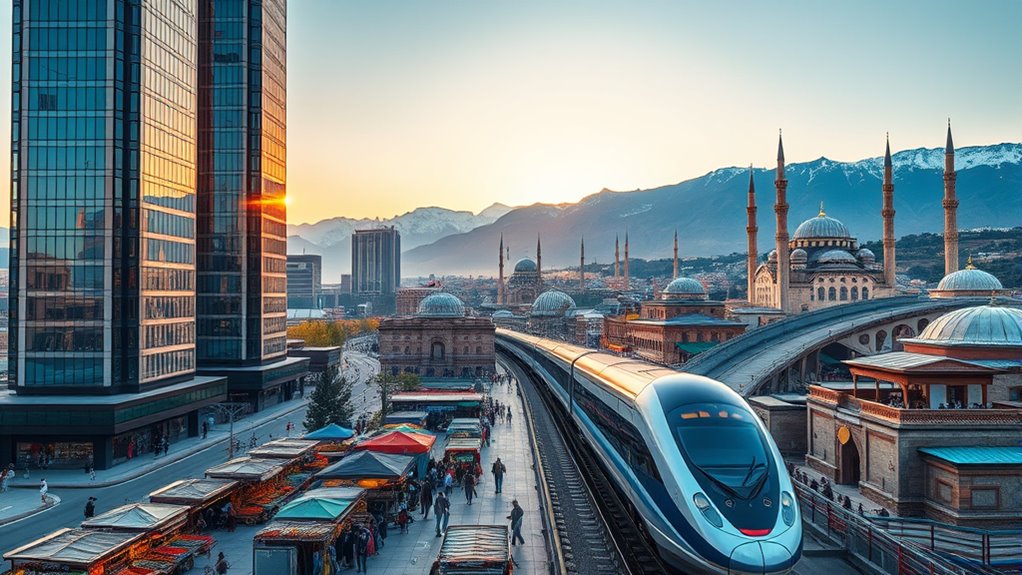
As you travel along the modern Silk Road, you’ll encounter historic trade cities that once thrived as cultural hubs. You’ll also cross rugged mountain passes and stop at desert oases that have sustained travelers for centuries. These destinations offer a vivid glimpse into the route’s rich history and diverse landscapes. To enhance your journey, consider exploring unique cultural elements that reflect the region’s rustic charm and historical significance. Engaging with local traditions can provide deeper insights into the area’s vibrant past and present, especially through the use of innovative electric bike conversion kits that make exploring these terrains more accessible and enjoyable. Additionally, choosing the right vetted equipment can ensure a smoother and more memorable adventure.
Historic Trade Cities
Have you ever wondered how ancient trade routes connected distant civilizations? These historic cities were vibrant hubs of commerce, culture, and innovation. Walking through them, you feel the pulse of history and the echoes of traders who once crossed deserts and mountains. Cities like Samarkand, Xi’an, and Bukhara served as crossroads of ideas and goods, shaping civilizations forever. Their architecture, markets, and stories invite you to imagine bustling caravans and shared traditions. These cities still stand as testaments to human resilience and ingenuity, waiting for you to explore their timeless charm. Many of these locations also reflect cultural narratives promoted through centuries of exchange and storytelling. Today, they are also celebrated for their role in fostering personal growth and cross-cultural understanding through their rich histories. Exploring these sites can inspire personal development by connecting you to a shared human heritage and diverse perspectives.
Mountainous Crossings
From the bustling markets and historic streets of Silk Road cities, your journey naturally leads into the rugged terrain of mountain crossings that have long challenged travelers. As you ascend these formidable passes, you’ll encounter breathtaking scenery and ancient routes carved into cliffs. The Tian Shan and Pamir ranges demand careful navigation, but their stunning vistas reward your effort. Here, traders and explorers once braved altitude sickness and unpredictable weather, forging paths that connected distant civilizations. Modern roads and tunnels now ease the crossing, but the mountains still hold a sense of adventure and history. You’ll feel the weight of centuries of travelers before you, crossing these peaks to continue their journey east or west. The mountain crossings remain a crucial, awe-inspiring part of the Silk Road’s legacy, with historic trade routes still visible along many of these ancient paths. These routes exemplify the enduring significance of the Silk Road in connecting diverse cultures and fostering exchange. Many of these passes have been upgraded with modern infrastructure, making the journey safer while preserving their historic importance. The integration of advanced engineering techniques has also played a vital role in maintaining these routes amid challenging terrains.
Desert Oasis Stops
Why do desert oasis stops remain essential on the modern Silk Road? These stops offer crucial relief and refreshment amid the harsh desert landscape. They serve as vital resupply points for water, food, and shelter, ensuring travelers and traders can continue their journey safely. Oases also act as cultural hubs, where you can experience local traditions, sample regional cuisine, and connect with communities that have thrived here for centuries. These lush spots break the monotony of endless sands and provide a moment to rest and reflect. Without oasis stops, crossing the desert would be nearly impossible, making them indispensable landmarks. Today, they symbolize resilience and serve as gateways to exploring the diverse cultures that have shaped the Silk Road’s history.
Navigating the Cultural Mosaic of Central Asia
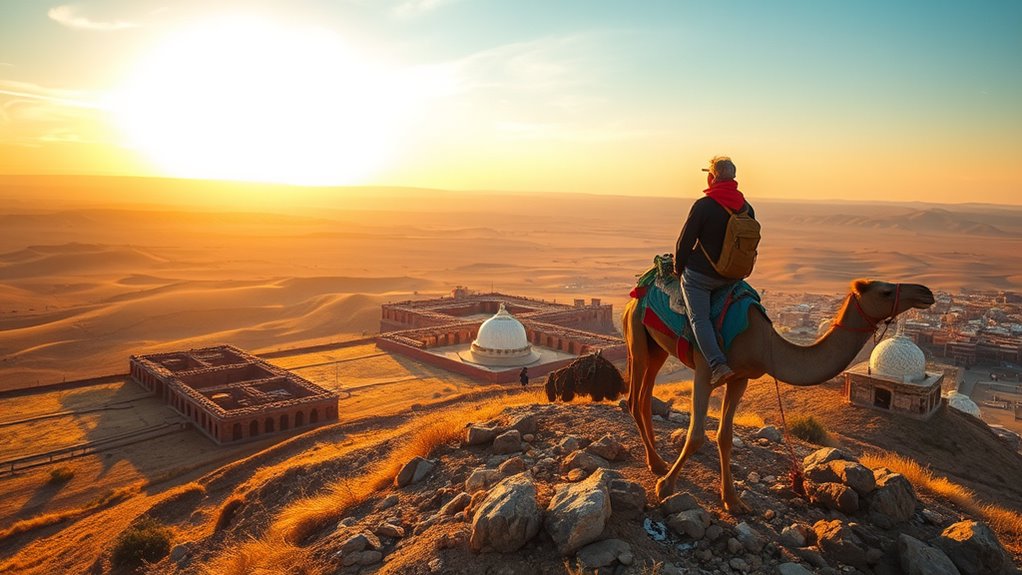
As you traverse Central Asia, you’ll discover a vibrant tapestry woven from diverse cultures, histories, and traditions. Each country offers unique customs, languages, and religious influences that shape the local way of life. You’ll encounter ancient traditions blending seamlessly with modern influences, creating a dynamic cultural mosaic. Interacting with locals, you’ll notice their hospitality and pride in heritage, from traditional music and dance to distinctive culinary flavors. Journeys through this region means embracing contrasts—where nomadic heritages coexist with urban development. You’ll find that understanding the cultural nuances enriches your journey, offering deeper insights into Central Asia’s complex identity. Developing an awareness of cultural differences can greatly enhance your appreciation and respect for the diverse communities you meet along the way. Embracing intercultural understanding can facilitate meaningful connections and foster mutual respect among the various peoples you encounter. Recognizing the importance of cultural preservation can also deepen your appreciation for the region’s rich history and ongoing traditions.
Exploring the Vibrant Markets and Local Crafts
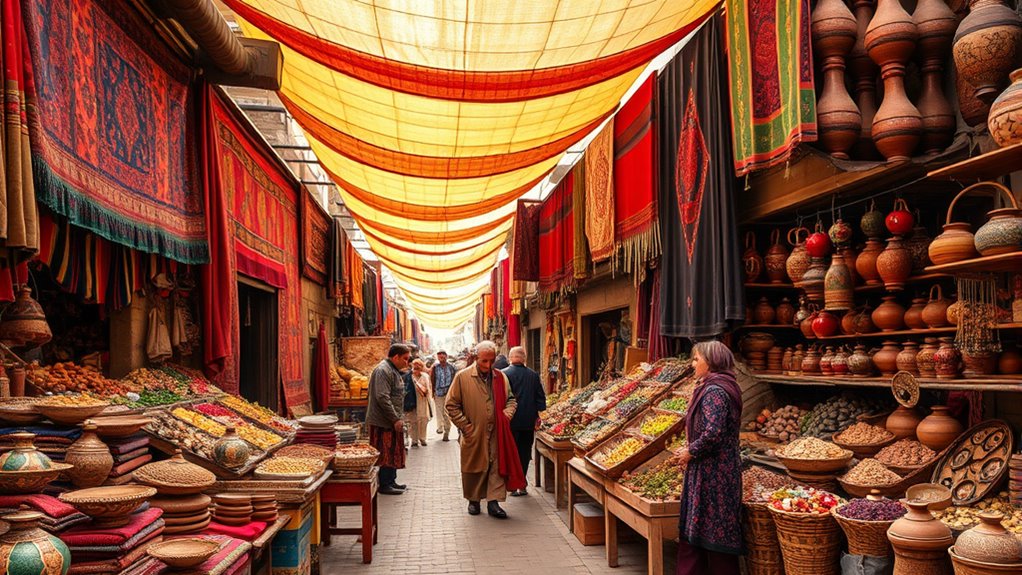
As you wander through the bustling market streets, you’ll be surrounded by an array of vibrant sights and sounds. Local artisans showcase their handcrafted goods, each piece telling a unique story. These markets offer a firsthand glimpse into the rich traditions and creativity of the region. The lively atmosphere often reflects the influence of viral trends, which frequently originate from social media platforms like TikTok. Additionally, the variety of tableware on display highlights the importance of cultural significance, with many items crafted using traditional techniques that have been passed down through generations. Engaging in food safety practices can ensure that visitors enjoy the local delicacies safely while appreciating the culinary traditions.
Bustling Market Streets
Walking through the bustling market streets along the modern Silk Road, you’ll immediately feel the vibrant energy that fills the air. Vendors call out, offering fresh produce, spices, and textiles, creating a lively symphony of sounds. Stalls overflow with colorful goods, from fragrant herbs to intricate jewelry, inviting you to browse and haggle. The aroma of grilled meats and sweet pastries mixes with the scent of blooming flowers, tempting your senses. Locals and travelers alike move swiftly through narrow alleyways, exchanging smiles and stories. Every corner reveals a new discovery, whether it’s a handcrafted souvenir or a traditional dish. The atmosphere is electric, immersing you in the lively heartbeat of the market and connecting you deeply to the region’s rich culture. The vibrant energy of these markets is often complemented by the soothing presence of essential oils used by vendors to create inviting atmospheres.
Handcrafted Local Goods
Strolling through the vibrant markets, you’re drawn to the stunning array of handcrafted local goods on display. Bright textiles, intricate jewelry, and pottery catch your eye, each piece telling a story of tradition and craftsmanship. You can feel the skill and passion poured into every item, from woven scarves to carved wooden figurines. Vendors enthusiastically share the history behind their creations, offering personalized insights and stories. As you browse, you realize that shopping here isn’t just about acquiring souvenirs—it’s about connecting with local culture and appreciating the artistry behind each piece. You may even try your hand at traditional crafts or negotiate prices, immersing yourself in the lively market atmosphere. These handmade goods reflect centuries of heritage, making your journey along the Silk Road even more meaningful. Additionally, understanding the beneficial ingredients in local products can deepen your appreciation for their quality and cultural significance. Exploring nutritional benefits can enrich your understanding of the health and wellness traditions embedded in local craft foods. Discovering the authentic ingredients used in traditional recipes adds another layer of cultural appreciation to your experience.
Discovering Architectural Marvels and Ancient Sites
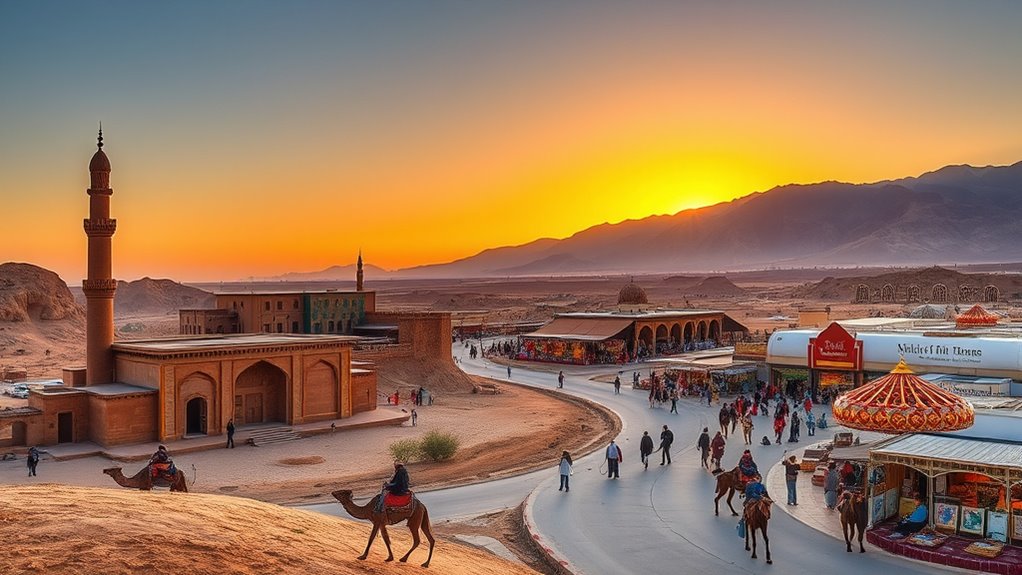
The Silk Road is dotted with architectural marvels and ancient sites that reveal the rich history and diverse cultures along the route. As you explore, you’ll encounter grand mosques, ancient fortresses, and well-preserved ruins that tell stories of traders and travelers. These sites showcase unique craftsmanship and architectural styles from different eras and regions. To deepen your understanding, consider these highlights:
| Site | Location | Significance |
|---|---|---|
| Samarkand Registan | Uzbekistan | Iconic Islamic architecture and trading hub |
| Dunhuang Caves | China | Buddhist art and ancient manuscripts |
| Persepolis | Iran | A symbol of Persian imperial power |
| Meroë Pyramids | Sudan | Nubian royal tombs and ancient civilization |
Understanding the architectural diversity along the Silk Road can enhance your appreciation of the cultural exchange and historical significance of these sites. Exploring the diverse architectural styles helps illuminate the blending of different influences throughout history, reflecting the cultural exchange that has shaped the region over centuries. Recognizing the architectural influences from different cultures can provide a richer context for appreciating these historic sites.
Experiencing Traditional Cuisine and Culinary Delights
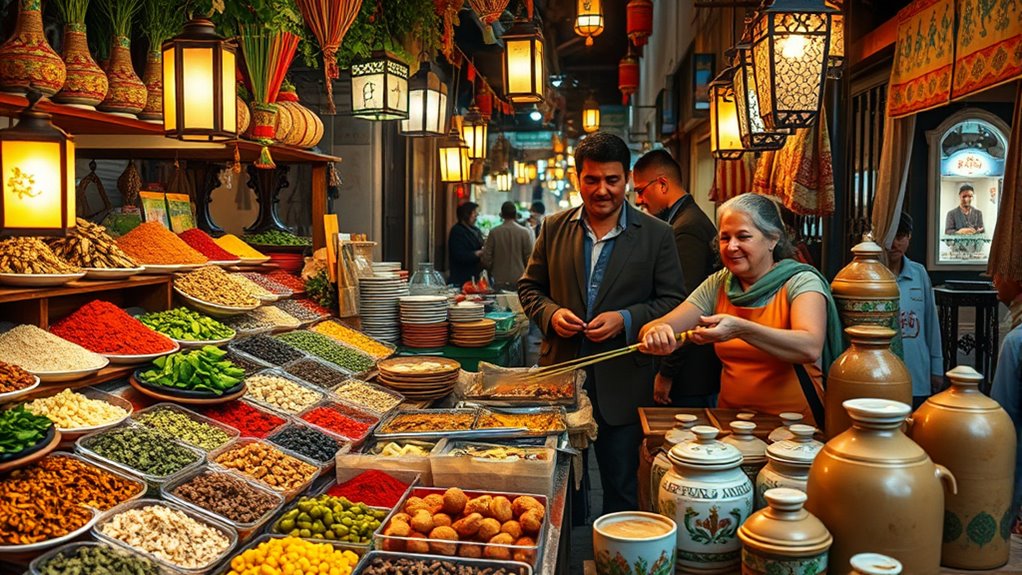
As you journey along the Silk Road, you’ll find that the region’s culinary traditions are as diverse and vibrant as its history. Every stop offers unique flavors, from aromatic spices in Central Asia to savory noodles in China. You can savor mouthwatering kebabs, fragrant pilafs, and fresh bread baked in traditional tandoors. Markets burst with colorful produce, herbs, and street snacks that invite you to taste local life. In Uzbekistan, try plov, a hearty rice dish packed with meat and vegetables, while in Iran, indulge in flavorful stews like ghormeh sabzi. Sampling these dishes connects you to centuries of cultural exchange, making each meal a journey of its own. The cultural significance of these foods enhances your appreciation of the region’s history. Embrace the flavors, and let your taste buds explore the rich culinary tapestry of the Silk Road.
Embracing Adventure: Trekking and Outdoor Activities
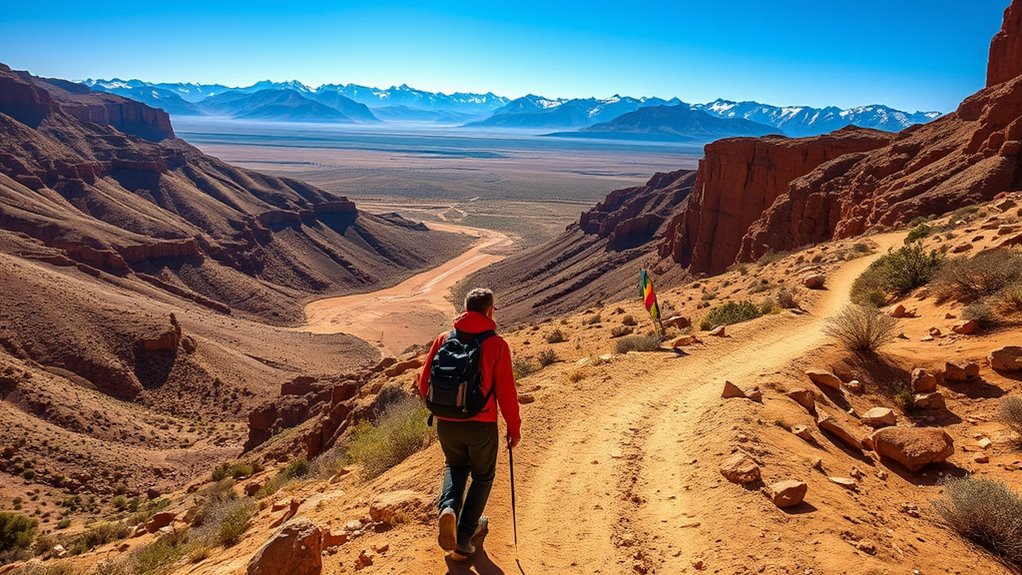
After savoring the rich flavors of Silk Road cuisine, it’s time to step outside and embrace the region’s rugged outdoor adventures. You can trek through breathtaking mountain passes, exploring ancient trade routes that once connected civilizations. The diverse landscapes invite activities like mountain biking, rock climbing, and horseback riding, offering a hands-on way to experience the region’s natural beauty. Whether you’re orienting yourself in the desert dunes or wandering lush valleys, outdoor adventures deepen your connection to the land’s history and culture. Guided tours and solo expeditions alike provide opportunities to challenge yourself while soaking in panoramic views. Prepare for varying terrains and weather conditions, and don’t forget your essentials. Embracing these activities transforms your journey into an active exploration of the Silk Road’s timeless wilderness.
Understanding the Economic Significance Today

Have you ever wondered how the Silk Road continues to shape today’s economies? Modern trade routes inspired by the historic path foster connectivity between Asia, Europe, and Africa. Countries leverage these routes to boost exports, attract investments, and develop infrastructure. The Belt and Road Initiative, for example, aims to create a network of roads, ports, and railways that facilitate faster, cheaper trade. This increases economic growth and job opportunities across regions. Local industries benefit from increased access to global markets, while consumers enjoy a wider variety of goods. The Silk Road’s influence extends beyond trade, promoting cultural exchange and regional stability. By strengthening economic ties, the modern route remains essential for global commerce and regional development, underscoring its enduring importance today.
Practical Tips for a Memorable Journey
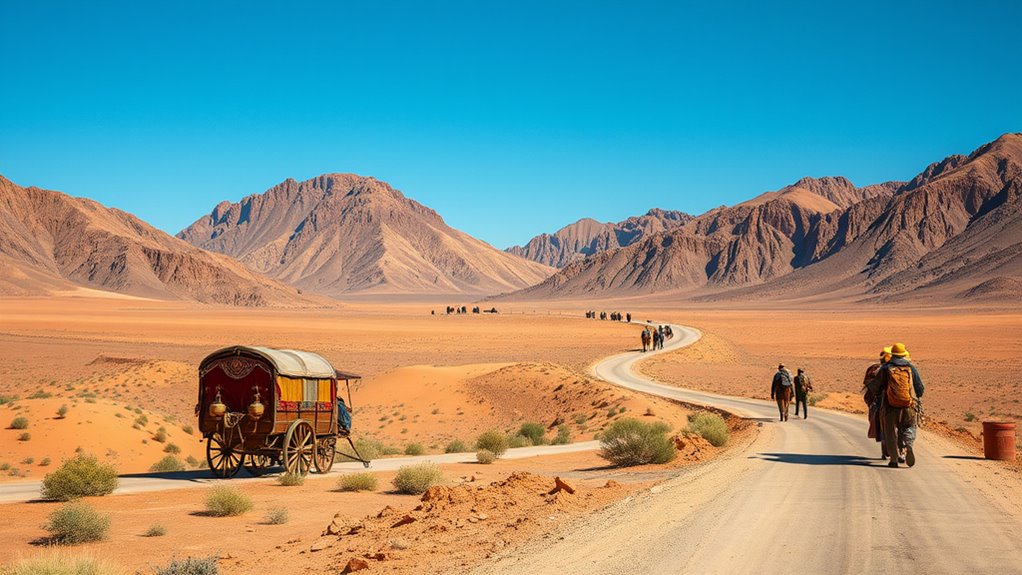
To guarantee your journey along the modern Silk Road is truly memorable, preparation is key. Research destinations thoroughly to understand local customs, language, and travel requirements. Pack smart—bring versatile clothing, necessary medications, and essential electronics with adapters. Keep digital copies of important documents like your passport and travel visas. Stay flexible; plans may change, so embrace spontaneous adventures. Learn a few basic phrases in local languages to connect with residents. Always carry some cash in local currency, but rely on card payments where possible. Respect cultural traditions and environmental guidelines to ensure a positive experience. Finally, maintain an open mind and curiosity—your genuine interest will make every encounter richer and your journey unforgettable.
Frequently Asked Questions
What Are the Best Months to Travel Along the Modern Silk Road?
The best months to travel along the modern Silk Road are typically spring (April to June) and fall (September to October). During these times, the weather is mild and pleasant, making your journey more enjoyable. Summer can be very hot, especially in desert areas, while winter might bring cold and snow in mountainous regions. Planning your trip during these ideal months guarantees comfortable travel and better sightseeing experiences.
How Can Travelers Ensure Respectful Interactions With Local Communities?
It’s wise to approach your travels with cultural sensitivity and genuine curiosity. You can guarantee respectful interactions by learning about local customs before visiting, listening carefully, and observing social cues. Show appreciation for traditions through polite gestures and appropriate dress. When in doubt, ask permission before taking photos or engaging in activities. By demonstrating humility and openness, you foster positive connections and enrich your experience with authentic, meaningful exchanges.
Are There Guided Tours Available for Exploring Remote Silk Road Regions?
You’ll find guided tours available for exploring remote Silk Road regions, making your journey more manageable and enriching. These tours often include local guides who know the area well, ensuring you get authentic experiences while respecting local customs. Booking through reputable companies guarantees safety and support. With guided tours, you’ll gain deeper insights into history, culture, and landscapes, making your adventure both meaningful and enjoyable.
What Safety Precautions Should Adventurers Consider on This Route?
Did you know that over 70% of travelers report safety concerns on remote routes? You should always research local conditions, carry emergency supplies, and stay in reputable guided tours. Keep your documents secure, avoid risky areas, and stay connected with local authorities. Trust experienced guides, follow their advice, and respect local customs. With proper precautions, you can enjoy your adventure safely and make the most of this historic journey.
How Has Modern Technology Transformed Travel Experiences Along the Silk Road?
Modern technology has completely transformed your travel experience along the Silk Road. GPS and real-time maps help you navigate unfamiliar territories with confidence, while translation apps break down language barriers. You can easily access online reviews, book accommodations, and stay connected through social media. These tools make your journey safer, more efficient, and more immersive, allowing you to explore richer cultural experiences while staying informed and in control throughout your adventure.
Conclusion
You might think modern travel along the Silk Road is complicated, but with a little planning, it’s an unforgettable adventure. Embrace the rich history, vibrant cultures, and breathtaking landscapes that await. Don’t let concerns about logistics hold you back—this journey offers unique stories and experiences you’ll treasure forever. So pack your curiosity and sense of adventure, and discover how this ancient route still connects us today in exciting new ways.
